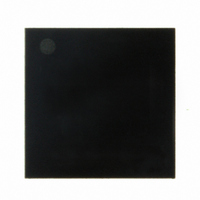TRC103 RFM, TRC103 Datasheet - Page 49

TRC103
Manufacturer Part Number
TRC103
Description
RFIC TRANSCEIVER MULTI-CHANNEL F
Manufacturer
RFM
Series
TRCr
Datasheet
1.TRC103.pdf
(64 pages)
Specifications of TRC103
Frequency
863MHz ~ 960MHz
Data Rate - Maximum
100kbps
Modulation Or Protocol
FSK, OOK
Applications
General Purpose
Power - Output
11dBm
Sensitivity
-112dBm
Voltage - Supply
2.1 V ~ 3.6 V
Current - Receiving
4mA
Current - Transmitting
30mA
Data Interface
PCB, Surface Mount
Antenna Connector
PCB, Surface Mount
Operating Temperature
-40°C ~ 85°C
Package / Case
32-QFN
Lead Free Status / RoHS Status
Lead free / RoHS Compliant
Memory Size
-
Other names
583-1095-2
6.3.2 OOK Demodulator Related Configuration Values
OOK demodulation in the TRC103 is accomplished by comparing the RSSI to a threshold value. An RSSI value
greater than the threshold is “sliced” to a logic 1, and an RSSI value equal or less than the RSSI value is sliced to
a logic 0. The TRC103 provides three threshold options - fixed threshold, average-referenced threshold, and
peak-referenced threshold. MCFG01 bits 4..3 select the OOK threshold as shown in Table 58:
The configuration settings for each of these threshold options depends directly or indirectly on the bit rate.
The fixed-threshold value is configured in MCFG04 bits 7..0. The fixed threshold can be adjusted in 0.5 dB incre-
ments over a range of 128 dB. Also, the gain of the IF can be adjusted over a range of 13.5 dB to reduce the
RSSI value under no signal conditions. MCFG01 bits 1..0 select the IF gain as shown in Table 59:
The useable threshold setting depends on the RF operating band, the bandwidths of the receiver filters, the RF
noise generated by host circuitry, the RF noise generated in the application environment, and the antenna effi-
ciency. The fixed threshold is adjusted heuristically by incrementing the threshold while monitoring the data output
pin with an oscilloscope. The threshold is adjusted upward under no signal conditions until noise spikes on the
data output are reduced to an average of one spike every five or more seconds. Because the fixed threshold has
no automatic adjustment capability, it should only be used in applications where incidental RF noise generators
such as PCs, switchgear, etc., are not present.
The average-referenced threshold is generated by passing the RSSI signal through a low-pass filter. Two cutoff
frequencies can be configured for this filter. This selection is done with RXCFG15 bit1. A 0 value selects F
1 value selects F
Where F
value is limited to 8, and F
long 1-0-1-0… preamble must be transmitted to center the threshold for each cutoff frequency. A preamble of at
www.RFM.com
©2009-2010 by RF Monolithics, Inc.
F
and
F
CAS
CAS
CAL
and F
= BR/(32*π) = 0.01*BR
= BR/(8*π) = 0.04*BR
E-mail:
CAL
CAL
:
info@rfm.com
are in kHz and BR is in kb/s. F
CAL
is used when a sequence of bits of the same value is limited to 32. An adequately
Pattern of Bits 7..4
Pattern of Bits 4..3
Pattern of Bits 1..0
Technical support +1.800.704.6079
1101
1110
1111
00
01
10
11
00
01
10
11
CAS
Table 57
Table 58
Table 59
is used when a sequence of received bits of the same
R-C Filter Bandwidth
average referenced
peak referenced
Threshold
maximum
not used
514 kHz
676 kHz
987 kHz
-13.5 dB
IF Gain
-4.5 dB
-9.0 dB
fixed
TRC103 - 12/15/10
Page 49 of 64
CAS
and

















